View current page
...more recent posts
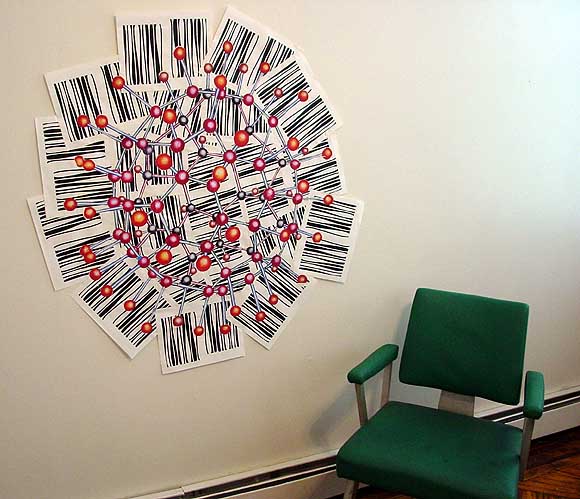
The above piece, Fuzzyball, has been shipped over to Manchester, UK, for the Futuresonic festival. It's in an exhibit called "Fuzzy Logic," which is a subset of another exhibition called "Low Grade" that is part of the larger festival. The curators are Jackie Passmore and Michael Connor. By the way, the molecule above really is called a "fuzzyball" (a buckyball variant); I didn't title it just for the show. Here's the rundown on "Fuzzy Logic":
"Low Grade" argues that the roots of computing technology are linked to Britain's 19th Century cotton trade, with weaving looms providing inspiration for the design of the first computer. In a city famous for both its textile history - Manchester was once known as "Cottonopolis" - and as the birthplace of the modern computer, "Fuzzy Logic" demonstrates how new media artists are turning back to the loom, combining technology with the knitting needle to create a new wave of fabric-based media arts, mathematical knitting and textile activism.My piece doesn't involve knitting but I have always described this type of work as a paper quilt or mosaic. When I started doing these pieces in the mid-90s I was very interested in cyberfeminist Sadie Plant, who is speaking at the festival, and I was somewhat chagrined to discover no one in the NY art world was following this dialogue, or giving any particular thought to bridging the computational and the crafted. Things have gotten better in the last few years with the arrival on the scene of many of the above artists, so I'm not feeling quite as lonely as I did in 1997, when the gallery I was showing with mostly just apologized for the work, as in "Sorry it's not made with a brush or pencil and fabricated of fine, durable art materials, we know how important that is to you, Mrs. Drysdale." As late as 2001, a dealer I was working with was still asking me questions like "Do you ever think of painting these?"
Artists and works include:
Claire Irving (UK): Mathematical Knitting
Woolly Thoughts (UK): Mathematical Afghans
Cat Mazza (US): KnitPro Software, the LogoKnit knitting machine and examples of knitted work
Mandy McIntosh (UK): Knitting patterns for Atlanta and other cities, plus Radiant Circle
LoVid (US): Soft sound sculpture, sculpting psychedelic soundsssssssssssz
Peter Coffin (US): Wall-based prints bridging ASCII art and knitting patterns
Cory Arcangel (US): Security blanket based on the "infinite fill" patterns used in place of colour on early drawing software Mac Paint
Rebecca Vaughan (US): Conceptual knitted cosies for uncosy environments
Tom Moody (US): Psychedelic and abject works riding the guardrails between the handmade and the digital
"Cryptkicker" [mp3 removed]
I may do some more variations on this (minimal techno) piece. For the non-drum parts, I picked three (licensed!) samples that I thought were just exquisite and gave each its own track in the sequencer and its own octave for keymapping. The bass seems to go slightly out of phase because I left in all the trial balloons that eventually led to the main groove, sprinkling them in more or less randomly into the main sequence. The piano chords are appallingly simple and eventually I'd like to add some juicier melodies. The synth stab I left as is, because it sounds so seductively weird and funny.
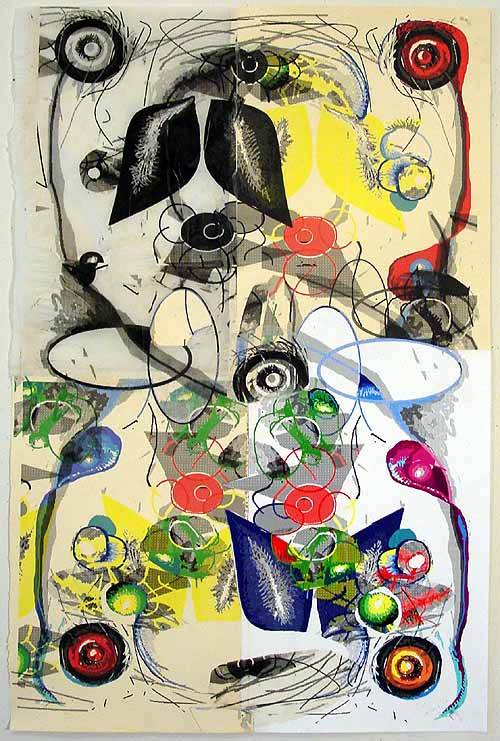
Zipatone Omniverse, 2005--this piece will be donated to the Dieu Donne Papermill (accent agu over the e in Donne screws up my RSS) for its annual benefit. Quite a challenge to figure out a way to incorporate their fine handmade artist's paper into my usual slacker vibe. I settled for practically destroying a couple of sheets in the printer and then trying to salvage them with tape and glue stick. This piece really looks handmade (and kind of "1930s surrealism") to me--even though all the drawing/markmaking was done in MSPaintbrush.
More on "extreme abstraction": Adolescent ranting aside, there is always the inherent contradiction of packaging work as extreme or "out there" when it's acceptable enough to curatorial and collector sensibilities to be in a major museum. I don't know David Batchelor's work but the rest of the choices in the Albright-Knox's "Extreme Abstraction" show are bread-and-butter practitioners. Each got noticed for bringing a little added oomph to the art world's workaday business of moving paintings. Besemer is "excessive" in the sense of "look at all those damn tiny stripes, can you believe someone sat there and painted those by hand with a brush?" but her paintings are perfectly crafted modular artifacts that are ultimately quite soothing to collector sensibilities. I'm really not sure what's supposed to be extreme about David Reed, unless it's the polish and seamlessness he brings to his surfaces. Katharina Grosse's best wall paintings do have a bit of that messy graffitti edge but compared to say, Jonathan Borofsky's rambunctious wall fillers of yore she seems positively sedate. In a sense all abstraction is extreme because no one gets it except a handful of aging art world initiates and it still has the capacity to inspire hostility after all these years. (I realize "extreme abstraction" as an exhibition title is sort of a joke and don't want to belabor this.)
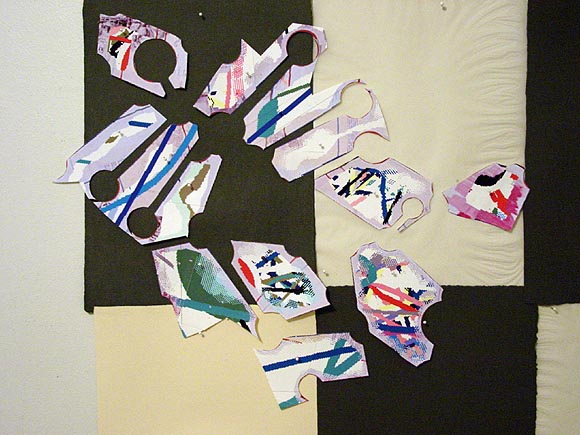
Posting has been lighter than usual because I've had some time-consuming things going on in the studio and frankly I need a break. For the next little while it's just going to be nerdy introspective private jokes and willfully obscure art around here.
I'm reposting this 'cause I'm afraid the joke wasn't clear. Barbara Kruger... Freddy Krueger... The '80s... Oh well...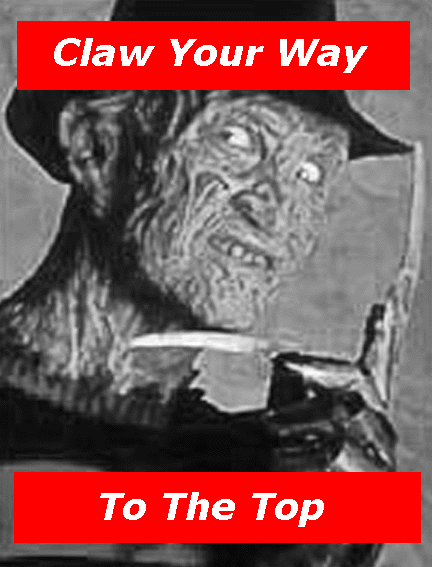 |
Extreme Abstraction. (See previous post.) Actually Linda Besemer, one of the artists in the Albright-Knox's show of that name, isn't extreme. Why is she extreme--because she's anal-retentive and makes hundreds of super thin stripes? Why does the art world insist on obsessive repetitive complexity as a rite of passage? And Katharina Grosse--she's extreme because she paints on the walls? Why is covering a lot of wall surface area a rite of passage? And David Reed--why is he extreme? Because he's so polished and professional? My favorite piece of his is probably the video where he (poorly) digitally inserted one of his paintings into the background of the Michael Mann-produced '80s TV series Crime Story. Dennis Farina and some other guy are arguing and the whole time there's this jerking, shimmering abstract painting on the wall behind them. It wasn't extreme, but it was a good piece.
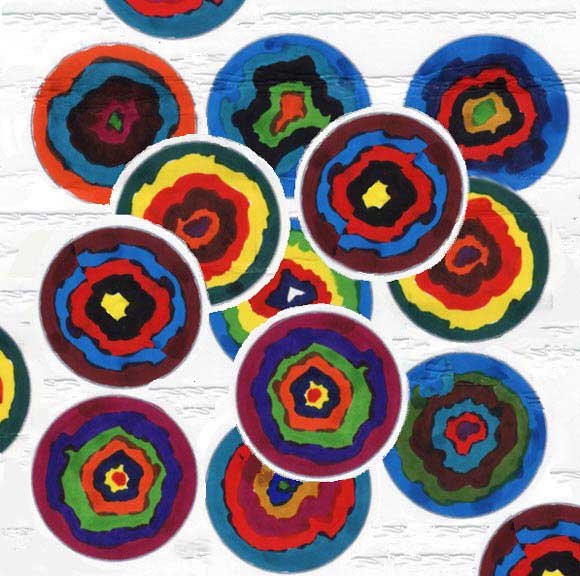
Albright Knocks
Chris Ashley describes a frustrating visit to the Albright-Knox museum in Buffalo here. Seems the museum is, um, fudging on the terms of its gift of Clyfford Still paintings:
When I was ready to see the Stills I asked someone at the desk where his paintings are.Also amusing is the press release for an upcoming show there called "Extreme Abstraction," featuring Linda Besemer, David Reed, David Batchelor, and Katharina Grosse, which also consists of "Extreme Fundraising Events," an "Extreme Dinner," and an "Extreme After Party." There is an extreme space commitment, as well--Chris says large parts of the collection were unviewable while the museum prepared for it."Oh, yeah, we showed him a few months ago."
"You mean there are none on display right now?"
"No, we just showed them."
"Doesn't that violate the conditions of his gift, that a portion be displayed in a dedicated room at all times?"
(Shrug) "I don't know anything about that."
Huh? On the web page regarding the Albright's Stills it says, "According to the terms of the gift, the paintings must be shown in their own room, all of the time, and never loaned to other museums." OK!
Afterthought on Clyfford Still: I kind of like those craggy, ultraserious paintings, which I saw at the A-K in '94, and the "stoner concentration" Still paid to his edges, as one painter I know put it. Hey, someone has to defend that holy-terror-even-in-death.
